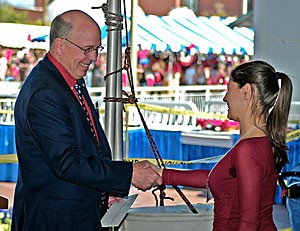One hundred and sixty students competed for more than $10,000 in prizes at this Homecoming weekend’s annual Student Showcase, hosted by the Graduate and Professional Student Council.
Starting Friday, the event presented 119 student projects, including a live dance performance, a research project on conversation, a Native American magazine and explorations into the effects of uranium mine tailings on the human body.
Monica Yellowhair, a pharmacology and toxicology graduate student who won in the categories of Health Sciences and Community Outreach, said she researched the effects of depleted uranium exposure to the lining of the bronchial passages.
Yellowhair’s research focused on both the mining boom of the late 1940s and early 1950s and on the more recent exposure to depleted uranium in U.S. military personnel.
Prolonged exposure to depleted uranium has been linked to the increase of several cancers, she said, including those of the pancreas, stomach, colon and prostate. Birth defects and still births also rose.
Yellowhair’s research concluded that cellular oxidative stress may not be a major pathway of depleted uranium genotoxicity, meaning the cells are not being poisoned by depleted uranium in the manner in which her research predicted.
“”It’s still getting in the cells somehow,”” she said of the uranium. Yellowhair said her research conclusion eliminates one pathway so she can start studying others, which is what she plans to do.
Shannon Holleran, a psychology graduate student, said she researched college-student conversations by attaching electronically activated recorders, PDAs with special software and microphones, to 175 students and recording 11,000 30-second conversations.
Holleran said she hypothesized at the beginning of the project that conversation topics would correlate strongly to personality traits, but she found that this was not true.
Holleran said she found out that most college students do not talk about sex, drugs and alcohol, despite popular belief.
Out of 16 topics of conversation, cigarettes, drugs or alcohol made up only 1.1 percent of conversations, placing it second to last on the list, according to Holleran’s research.
Instead, college students talk about entertainment – television, movies and sports – and relationships – boyfriends or girlfriends, family and friends.
In addition, topics related to school, such as teachers, tests and studying, were popular, according to the research.
Talk about the home domain, such as buying groceries, cleaning and organizing, beat out talk of fashion, money, politics and religion, which was last, according to Holleran’s research.
Another project at the event was a magazine called Red Ink, which showcases Native American art, photography and writing.
“”We’re the only Native American magazine that focuses on both academic and nonacademic work like poetry,”” said Marlana Laughter, co-managing editor and an English junior.
The magazine, which has been published since 1989 and prints 500 copies of each issue every semester, is about showing people a different side of Native Americans, Laughter said.
Issues are usually themed, including this semester’s environmental and sacred places issue, Laughter said. The magazine has even had children’s issues.
The 119 projects were judged by a panel of faculty, students and community members.
President’s Award winners were selected as the best in the showcase, and each won $500 on top of the $250 for first place in category. They were Eri Nakatani, a biochemistry senior, for “”Targeting HIV-1 Capsid Proteins Utilizing a Multivalent Approach”” for Best Exhibit by an Undergraduate Student, and Kimberly Adilia Helmer, a second language acquisition and teaching graduate student, who did “”Year One at City High School: Resistance in a Spanish Class for Heritage Learners”” for Best Exhibit by a Graduate Student.









